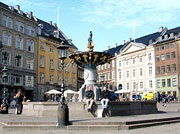丹麦首都-哥本哈根
|
Copenhagen (Denmark)  StrogetCopenhagen has been the capital of Denmark for 600 years and is also the largest city in Scandinavia, but it hasn't let these high-ranking geopolitical facts go to its urban head - the city maintains a refreshingly low-level approach to the modernisation of its historic skyline, while its high-spirited denizens party in the streets. The city's seemingly interminable(无止尽的)pedestrian mall, Stroget, supplies numerous options for shopping and entertainment, from street theatre to offstreet theatre, while the famous Tivoli fun park serves up amusement in more traditional forms and the cosmopolitan Latin Quarter will leave you covered in aromatic(芳香的;馨香的)coffee grounds. StrogetCopenhagen has been the capital of Denmark for 600 years and is also the largest city in Scandinavia, but it hasn't let these high-ranking geopolitical facts go to its urban head - the city maintains a refreshingly low-level approach to the modernisation of its historic skyline, while its high-spirited denizens party in the streets. The city's seemingly interminable(无止尽的)pedestrian mall, Stroget, supplies numerous options for shopping and entertainment, from street theatre to offstreet theatre, while the famous Tivoli fun park serves up amusement in more traditional forms and the cosmopolitan Latin Quarter will leave you covered in aromatic(芳香的;馨香的)coffee grounds.There's plenty of the green stuff in the city centre, with a couple of large parks and gardens in which to doze(打盹)or ramble(闲逛;漫步). If even that sounds too energetic, try a cruise through the canals of Christianshavn, saving just enough adrenalin(兴奋)for a courteous(殷勤的,谦恭的,有礼貌的)nod in the direction of the Little Mermaid. Architecturally, Copenhagen has more than its share of interesting sights, from the administrative palace of Christiansborg Slot on the island of Slotsholmen to the scenic steeple of Vor Frelsers Kirke. The Danish capital pretty much covers all the needs of the international visitor, and does it with typical Scandinavian assurance and flair(天资).  Many visitors enjoy taking boat rides through Copenhagen's canals. Many visitors enjoy taking boat rides through Copenhagen's canals.Copenhagen got its name from the word k?ben-havn, which means "merchants' harbor." It grew in size and importance because of its position on the sound, the body of water between Denmark and Sweden, guarding the entrance to the Baltic. From its humble beginnings, Copenhagen has become the largest city in Scandinavia, home to 1 1/2 million people. It's the seat of one of the oldest kingdoms in the world. Over the centuries Copenhagen has suffered more than its share of disasters. In the 17th century the Swedes repeatedly besieged it, and in the 18th century it endured the plague and two devastating fires. The British attacked twice during the Napoleonic wars in the early 1800s. Its last major disaster occurred in 1940 when the Nazis invaded Denmark and held it in their grip until 1945 when the British army moved in again, this time as liberators. Copenhagen still retains some of the characteristics of a village. If you forget the suburbs, you can cover most of the central belt on foot, making it a great place to visit. |








